Biology Report: Fitness Assessment and Anthropometry Analysis
VerifiedAdded on 2020/10/22
|10
|1660
|197
Report
AI Summary
This report presents a fitness assessment and anthropometry study, investigating the impact of exercise on the cardiovascular system. The experiment utilized adult male Wistar rats, subjecting them to various exercise regimens, including running. Anthropometric measurements and cardiovascular parameters, such as heart rate and blood pressure, were recorded and analyzed. The study aimed to evaluate the changes in cardiovascular function post-exercise and understand the effects of exercise on the body. The results, presented in tables, highlight the effects of exercise on the rats. Histological analysis of the caudal artery was also performed. The report concludes that exercise impacts the cardiovascular system and can affect vascular remodeling. The findings contribute to understanding the relationship between exercise and cardiovascular health.
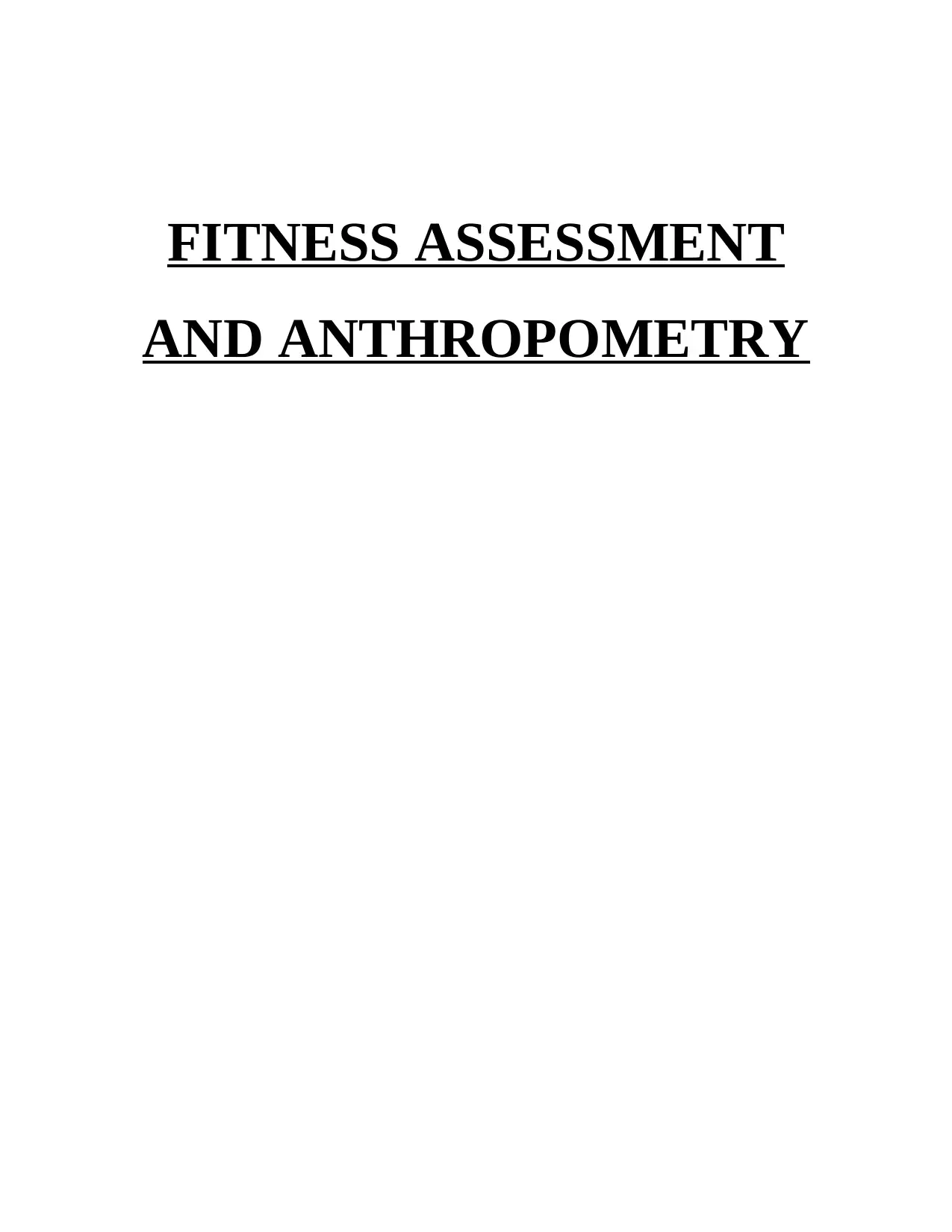
FITNESS ASSESSMENT
AND ANTHROPOMETRY
AND ANTHROPOMETRY
Paraphrase This Document
Need a fresh take? Get an instant paraphrase of this document with our AI Paraphraser
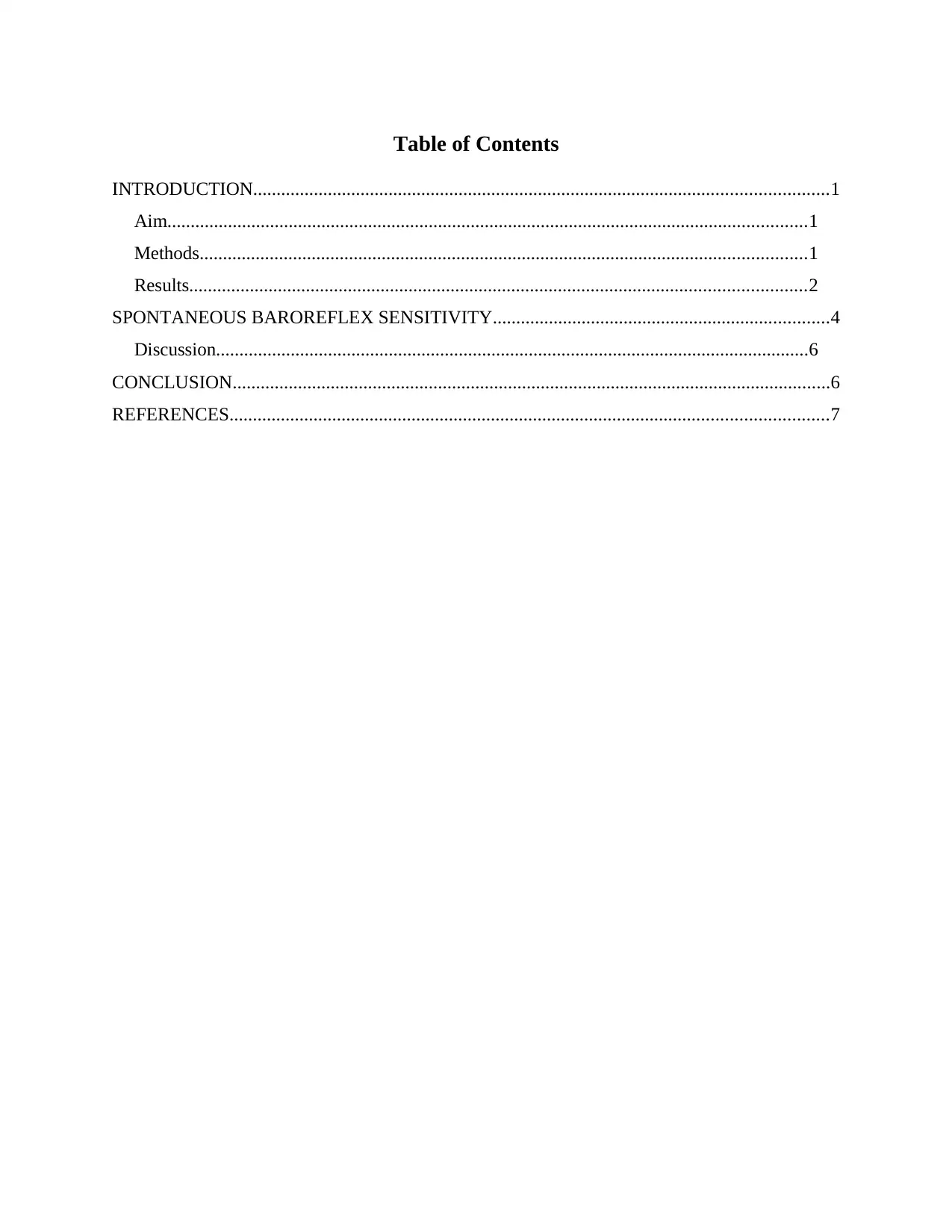
Table of Contents
INTRODUCTION...........................................................................................................................1
Aim.........................................................................................................................................1
Methods..................................................................................................................................1
Results....................................................................................................................................2
SPONTANEOUS BAROREFLEX SENSITIVITY........................................................................4
Discussion...............................................................................................................................6
CONCLUSION................................................................................................................................6
REFERENCES................................................................................................................................7
INTRODUCTION...........................................................................................................................1
Aim.........................................................................................................................................1
Methods..................................................................................................................................1
Results....................................................................................................................................2
SPONTANEOUS BAROREFLEX SENSITIVITY........................................................................4
Discussion...............................................................................................................................6
CONCLUSION................................................................................................................................6
REFERENCES................................................................................................................................7

INTRODUCTION
Cardiovascular system is an organic system that permits blood to circulate and transport
nutrients, oxygen, carbon dioxide, hormone and blood cells to body. Exercise places an increased
demand on the cardiovascular system. By exercising demand of oxygen supply is increases in the
muscles and metabolic process. Exercise such as; aerobics, endurance training have affects on
the system. Exercising lowers down the heart rate, amount of blood pumps enhances. Overall the
relation between exercise and cardiac system is positive for the fitness of body externally and
internally as well.
Anthropometry
Anthropometry is a science that deals with and universally applicable technique for
assessing the measurement of size, weight and proportions of the human body. It is a branch of
anthropology (Doyle and et. al., 2016).
Aim
The experiment is done by rat dissension that is because it is very likely to the human
body. The aim of the experiment is to evaluate the body system and the change in their
respective function after exercising (Swimming training increases cardiac vagal activity and
induces cardiac hypertrophy in rats, 2018).
Methods
Ethical approval
The method is approved by Ethics commission of the care and use of animals from the
Universidade federal de minas gerais. All the methods and procedures are conducted under the
regulation given by the UK national Council for the control of Animal Experimentation (Lavie,
and et. al., 2015). We make all the possible effort to use minimum number of rats in this
experiment.
Animals
In this experiment, we were used Adult male wistar rats and they subjected to three
various set of experiment in the total number of 50 rats that are 8 to 10 weeks old. The light,
temperature are as per the standard (Robinson and et. al., 2015).
Experimental design
1
Cardiovascular system is an organic system that permits blood to circulate and transport
nutrients, oxygen, carbon dioxide, hormone and blood cells to body. Exercise places an increased
demand on the cardiovascular system. By exercising demand of oxygen supply is increases in the
muscles and metabolic process. Exercise such as; aerobics, endurance training have affects on
the system. Exercising lowers down the heart rate, amount of blood pumps enhances. Overall the
relation between exercise and cardiac system is positive for the fitness of body externally and
internally as well.
Anthropometry
Anthropometry is a science that deals with and universally applicable technique for
assessing the measurement of size, weight and proportions of the human body. It is a branch of
anthropology (Doyle and et. al., 2016).
Aim
The experiment is done by rat dissension that is because it is very likely to the human
body. The aim of the experiment is to evaluate the body system and the change in their
respective function after exercising (Swimming training increases cardiac vagal activity and
induces cardiac hypertrophy in rats, 2018).
Methods
Ethical approval
The method is approved by Ethics commission of the care and use of animals from the
Universidade federal de minas gerais. All the methods and procedures are conducted under the
regulation given by the UK national Council for the control of Animal Experimentation (Lavie,
and et. al., 2015). We make all the possible effort to use minimum number of rats in this
experiment.
Animals
In this experiment, we were used Adult male wistar rats and they subjected to three
various set of experiment in the total number of 50 rats that are 8 to 10 weeks old. The light,
temperature are as per the standard (Robinson and et. al., 2015).
Experimental design
1
⊘ This is a preview!⊘
Do you want full access?
Subscribe today to unlock all pages.

Trusted by 1+ million students worldwide
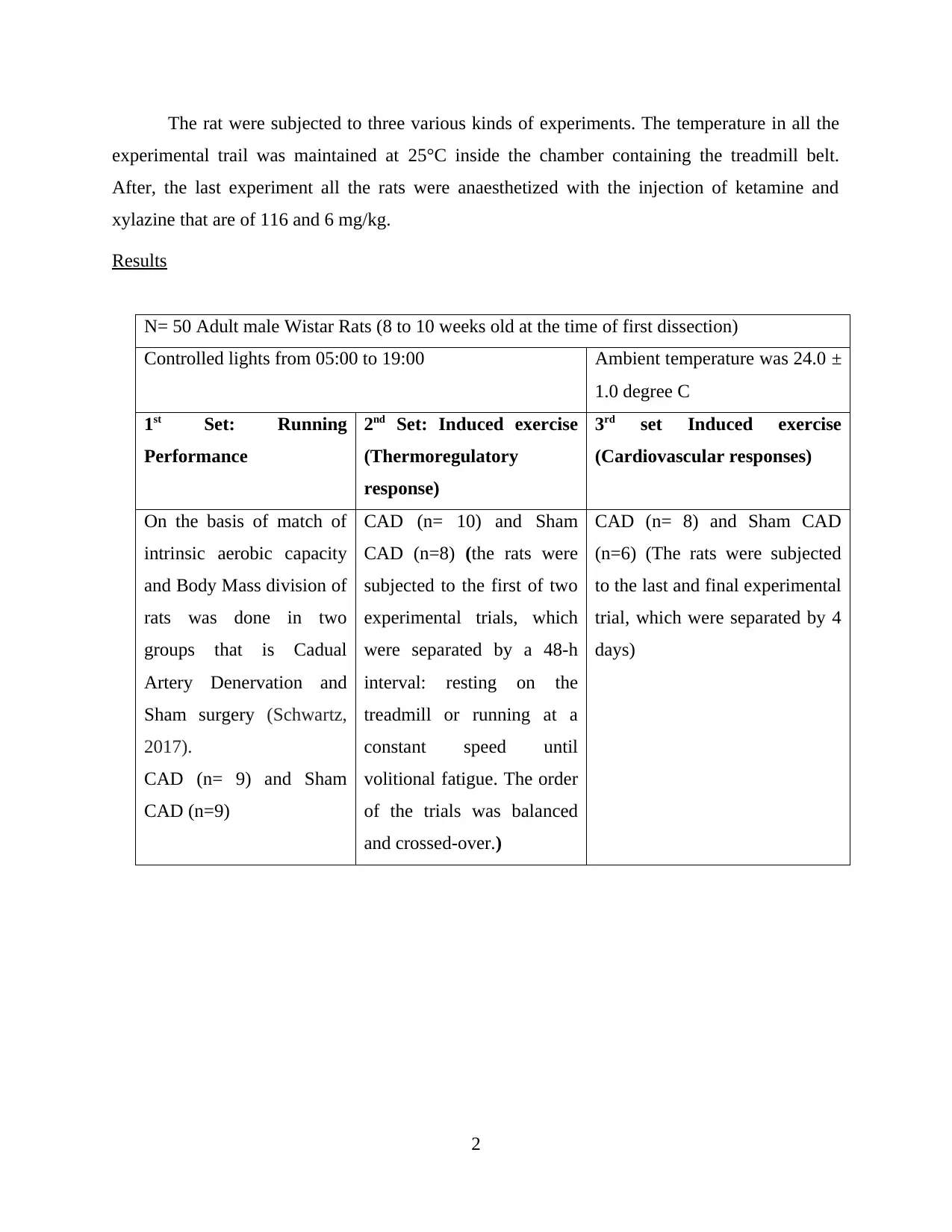
The rat were subjected to three various kinds of experiments. The temperature in all the
experimental trail was maintained at 25°C inside the chamber containing the treadmill belt.
After, the last experiment all the rats were anaesthetized with the injection of ketamine and
xylazine that are of 116 and 6 mg/kg.
Results
N= 50 Adult male Wistar Rats (8 to 10 weeks old at the time of first dissection)
Controlled lights from 05:00 to 19:00 Ambient temperature was 24.0 ±
1.0 degree C
1st Set: Running
Performance
2nd Set: Induced exercise
(Thermoregulatory
response)
3rd set Induced exercise
(Cardiovascular responses)
On the basis of match of
intrinsic aerobic capacity
and Body Mass division of
rats was done in two
groups that is Cadual
Artery Denervation and
Sham surgery (Schwartz,
2017).
CAD (n= 9) and Sham
CAD (n=9)
CAD (n= 10) and Sham
CAD (n=8) (the rats were
subjected to the first of two
experimental trials, which
were separated by a 48-h
interval: resting on the
treadmill or running at a
constant speed until
volitional fatigue. The order
of the trials was balanced
and crossed-over.)
CAD (n= 8) and Sham CAD
(n=6) (The rats were subjected
to the last and final experimental
trial, which were separated by 4
days)
2
experimental trail was maintained at 25°C inside the chamber containing the treadmill belt.
After, the last experiment all the rats were anaesthetized with the injection of ketamine and
xylazine that are of 116 and 6 mg/kg.
Results
N= 50 Adult male Wistar Rats (8 to 10 weeks old at the time of first dissection)
Controlled lights from 05:00 to 19:00 Ambient temperature was 24.0 ±
1.0 degree C
1st Set: Running
Performance
2nd Set: Induced exercise
(Thermoregulatory
response)
3rd set Induced exercise
(Cardiovascular responses)
On the basis of match of
intrinsic aerobic capacity
and Body Mass division of
rats was done in two
groups that is Cadual
Artery Denervation and
Sham surgery (Schwartz,
2017).
CAD (n= 9) and Sham
CAD (n=9)
CAD (n= 10) and Sham
CAD (n=8) (the rats were
subjected to the first of two
experimental trials, which
were separated by a 48-h
interval: resting on the
treadmill or running at a
constant speed until
volitional fatigue. The order
of the trials was balanced
and crossed-over.)
CAD (n= 8) and Sham CAD
(n=6) (The rats were subjected
to the last and final experimental
trial, which were separated by 4
days)
2
Paraphrase This Document
Need a fresh take? Get an instant paraphrase of this document with our AI Paraphraser
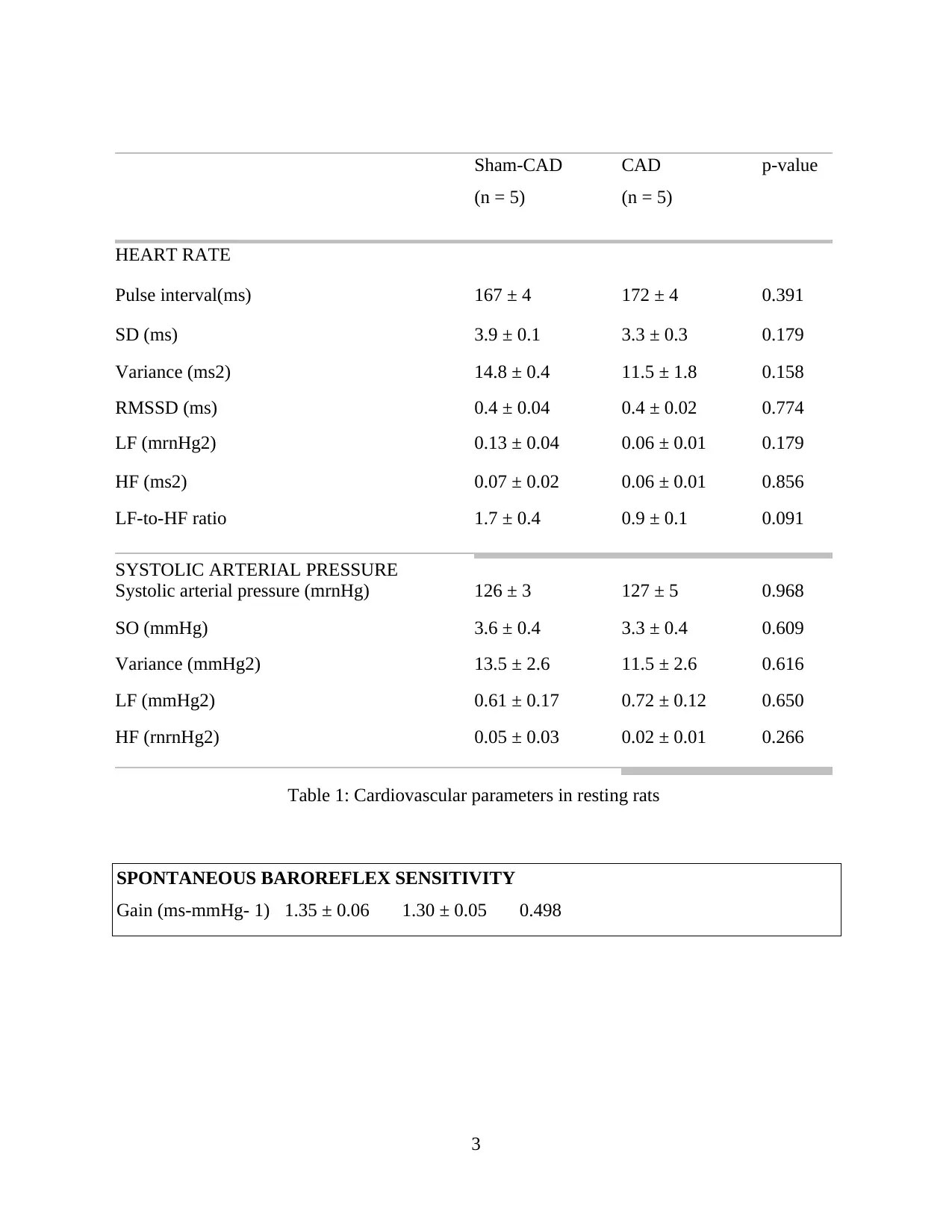
SPONTANEOUS BAROREFLEX SENSITIVITY
Gain (ms-mmHg- 1) 1.35 ± 0.06 1.30 ± 0.05 0.498
3
Sham-CAD
(n = 5)
CAD
(n = 5)
p-value
HEART RATE
Pulse interval(ms) 167 ± 4 172 ± 4 0.391
SD (ms) 3.9 ± 0.1 3.3 ± 0.3 0.179
Variance (ms2) 14.8 ± 0.4 11.5 ± 1.8 0.158
RMSSD (ms) 0.4 ± 0.04 0.4 ± 0.02 0.774
LF (mrnHg2) 0.13 ± 0.04 0.06 ± 0.01 0.179
HF (ms2) 0.07 ± 0.02 0.06 ± 0.01 0.856
LF-to-HF ratio 1.7 ± 0.4 0.9 ± 0.1 0.091
SYSTOLIC ARTERIAL PRESSURE
Systolic arterial pressure (mrnHg) 126 ± 3 127 ± 5 0.968
SO (mmHg) 3.6 ± 0.4 3.3 ± 0.4 0.609
Variance (mmHg2) 13.5 ± 2.6 11.5 ± 2.6 0.616
LF (mmHg2) 0.61 ± 0.17 0.72 ± 0.12 0.650
HF (rnrnHg2) 0.05 ± 0.03 0.02 ± 0.01 0.266
Table 1: Cardiovascular parameters in resting rats
Gain (ms-mmHg- 1) 1.35 ± 0.06 1.30 ± 0.05 0.498
3
Sham-CAD
(n = 5)
CAD
(n = 5)
p-value
HEART RATE
Pulse interval(ms) 167 ± 4 172 ± 4 0.391
SD (ms) 3.9 ± 0.1 3.3 ± 0.3 0.179
Variance (ms2) 14.8 ± 0.4 11.5 ± 1.8 0.158
RMSSD (ms) 0.4 ± 0.04 0.4 ± 0.02 0.774
LF (mrnHg2) 0.13 ± 0.04 0.06 ± 0.01 0.179
HF (ms2) 0.07 ± 0.02 0.06 ± 0.01 0.856
LF-to-HF ratio 1.7 ± 0.4 0.9 ± 0.1 0.091
SYSTOLIC ARTERIAL PRESSURE
Systolic arterial pressure (mrnHg) 126 ± 3 127 ± 5 0.968
SO (mmHg) 3.6 ± 0.4 3.3 ± 0.4 0.609
Variance (mmHg2) 13.5 ± 2.6 11.5 ± 2.6 0.616
LF (mmHg2) 0.61 ± 0.17 0.72 ± 0.12 0.650
HF (rnrnHg2) 0.05 ± 0.03 0.02 ± 0.01 0.266
Table 1: Cardiovascular parameters in resting rats
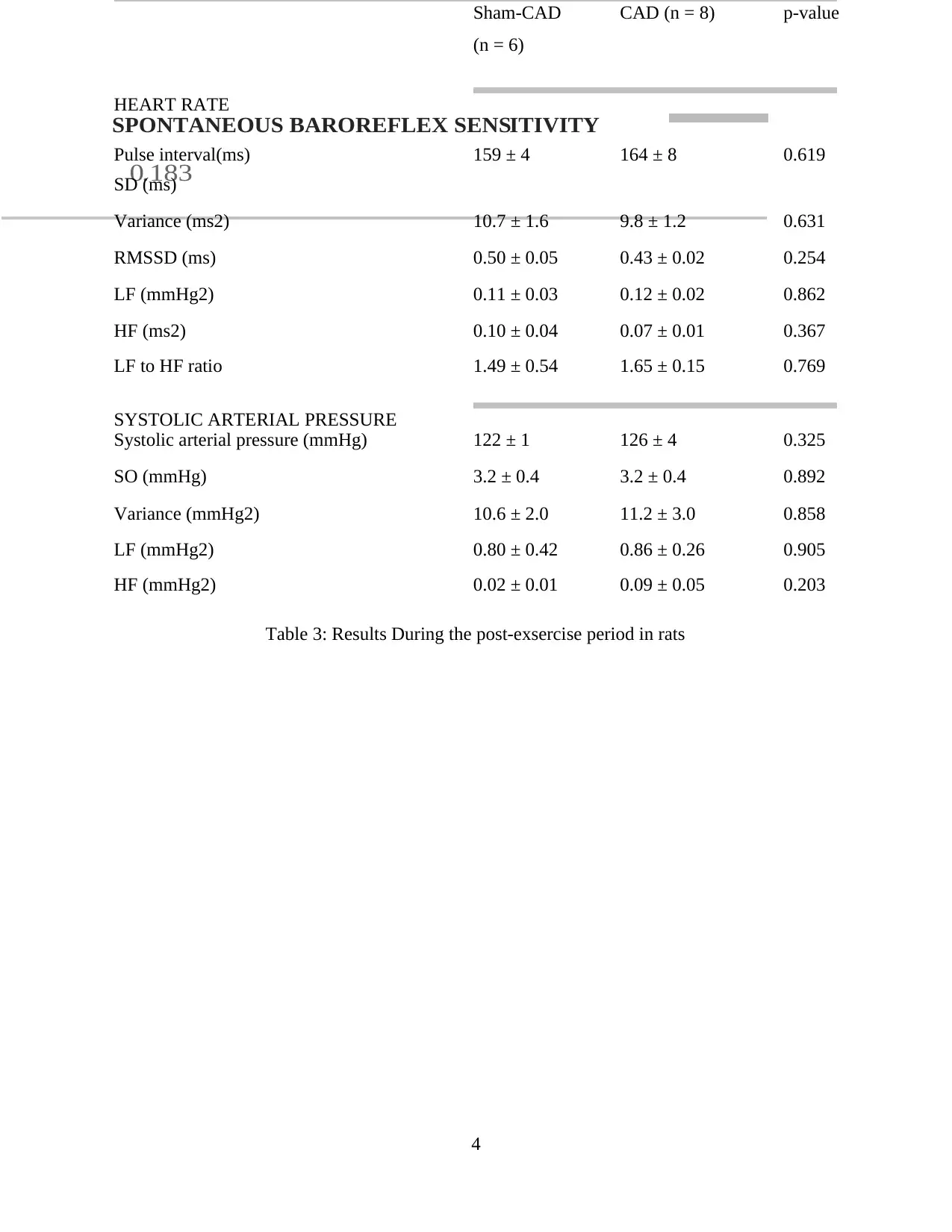
SPONTANEOUS BAROREFLEX SENSITIVITY
0.183
4
Sham-CAD
(n = 6)
CAD (n = 8) p-value
HEART RATE
Pulse interval(ms) 159 ± 4 164 ± 8 0.619
SD (ms)
Variance (ms2) 10.7 ± 1.6 9.8 ± 1.2 0.631
RMSSD (ms) 0.50 ± 0.05 0.43 ± 0.02 0.254
LF (mmHg2) 0.11 ± 0.03 0.12 ± 0.02 0.862
HF (ms2) 0.10 ± 0.04 0.07 ± 0.01 0.367
LF to HF ratio 1.49 ± 0.54 1.65 ± 0.15 0.769
SYSTOLIC ARTERIAL PRESSURE
Systolic arterial pressure (mmHg) 122 ± 1 126 ± 4 0.325
SO (mmHg) 3.2 ± 0.4 3.2 ± 0.4 0.892
Variance (mmHg2) 10.6 ± 2.0 11.2 ± 3.0 0.858
LF (mmHg2) 0.80 ± 0.42 0.86 ± 0.26 0.905
HF (mmHg2) 0.02 ± 0.01 0.09 ± 0.05 0.203
Table 3: Results During the post-exsercise period in rats
0.183
4
Sham-CAD
(n = 6)
CAD (n = 8) p-value
HEART RATE
Pulse interval(ms) 159 ± 4 164 ± 8 0.619
SD (ms)
Variance (ms2) 10.7 ± 1.6 9.8 ± 1.2 0.631
RMSSD (ms) 0.50 ± 0.05 0.43 ± 0.02 0.254
LF (mmHg2) 0.11 ± 0.03 0.12 ± 0.02 0.862
HF (ms2) 0.10 ± 0.04 0.07 ± 0.01 0.367
LF to HF ratio 1.49 ± 0.54 1.65 ± 0.15 0.769
SYSTOLIC ARTERIAL PRESSURE
Systolic arterial pressure (mmHg) 122 ± 1 126 ± 4 0.325
SO (mmHg) 3.2 ± 0.4 3.2 ± 0.4 0.892
Variance (mmHg2) 10.6 ± 2.0 11.2 ± 3.0 0.858
LF (mmHg2) 0.80 ± 0.42 0.86 ± 0.26 0.905
HF (mmHg2) 0.02 ± 0.01 0.09 ± 0.05 0.203
Table 3: Results During the post-exsercise period in rats
⊘ This is a preview!⊘
Do you want full access?
Subscribe today to unlock all pages.

Trusted by 1+ million students worldwide
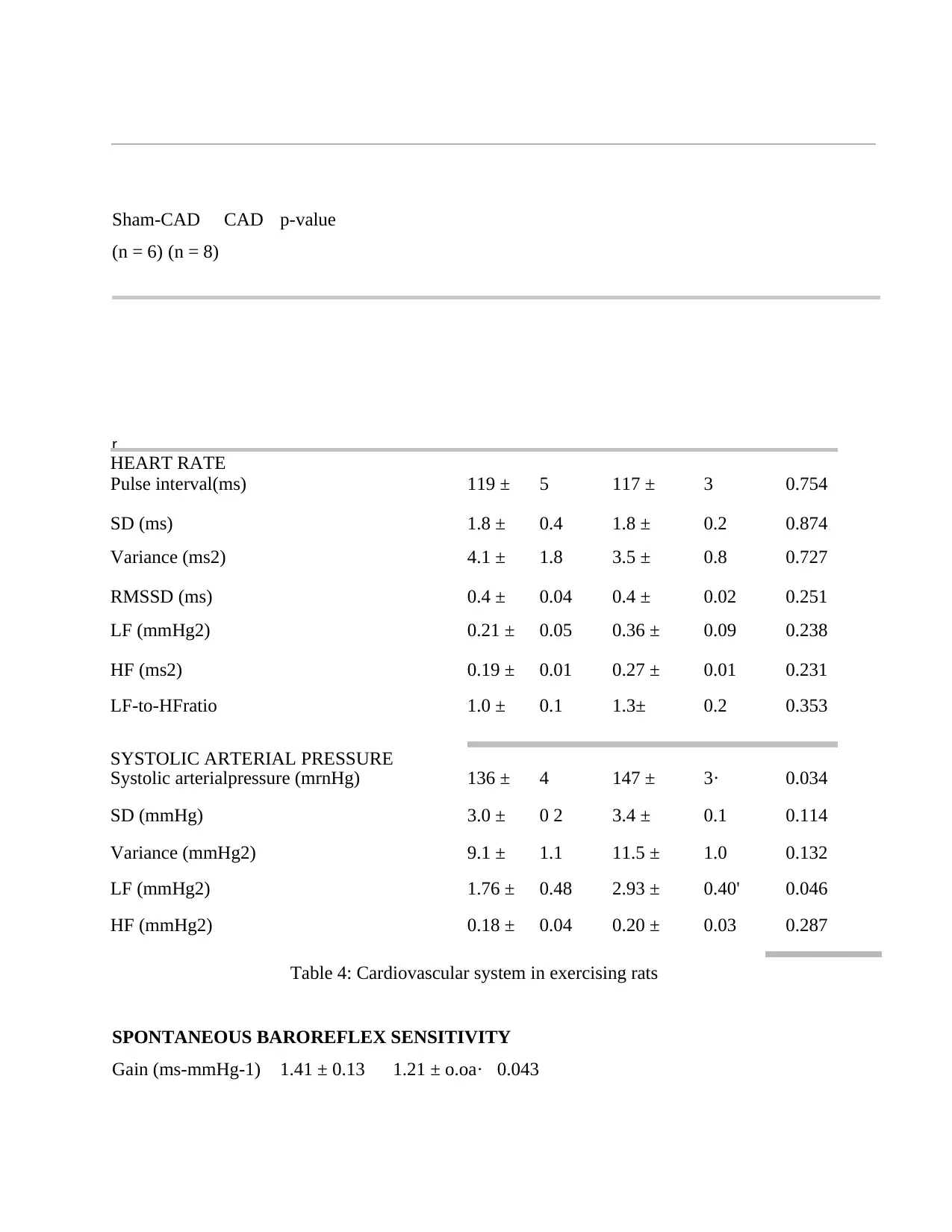
Sham-CAD CAD p-value
(n = 6) (n = 8)
r
SPONTANEOUS BAROREFLEX SENSITIVITY
Gain (ms-mmHg-1) 1.41 ± 0.13 1.21 ± o.oa· 0.043
HEART RATE
Pulse interval(ms) 119 ± 5 117 ± 3 0.754
SD (ms) 1.8 ± 0.4 1.8 ± 0.2 0.874
Variance (ms2) 4.1 ± 1.8 3.5 ± 0.8 0.727
RMSSD (ms) 0.4 ± 0.04 0.4 ± 0.02 0.251
LF (mmHg2) 0.21 ± 0.05 0.36 ± 0.09 0.238
HF (ms2) 0.19 ± 0.01 0.27 ± 0.01 0.231
LF-to-HFratio 1.0 ± 0.1 1.3± 0.2 0.353
SYSTOLIC ARTERIAL PRESSURE
Systolic arterialpressure (mrnHg) 136 ± 4 147 ± 3· 0.034
SD (mmHg) 3.0 ± 0 2 3.4 ± 0.1 0.114
Variance (mmHg2) 9.1 ± 1.1 11.5 ± 1.0 0.132
LF (mmHg2) 1.76 ± 0.48 2.93 ± 0.40' 0.046
HF (mmHg2) 0.18 ± 0.04 0.20 ± 0.03 0.287
Table 4: Cardiovascular system in exercising rats
(n = 6) (n = 8)
r
SPONTANEOUS BAROREFLEX SENSITIVITY
Gain (ms-mmHg-1) 1.41 ± 0.13 1.21 ± o.oa· 0.043
HEART RATE
Pulse interval(ms) 119 ± 5 117 ± 3 0.754
SD (ms) 1.8 ± 0.4 1.8 ± 0.2 0.874
Variance (ms2) 4.1 ± 1.8 3.5 ± 0.8 0.727
RMSSD (ms) 0.4 ± 0.04 0.4 ± 0.02 0.251
LF (mmHg2) 0.21 ± 0.05 0.36 ± 0.09 0.238
HF (ms2) 0.19 ± 0.01 0.27 ± 0.01 0.231
LF-to-HFratio 1.0 ± 0.1 1.3± 0.2 0.353
SYSTOLIC ARTERIAL PRESSURE
Systolic arterialpressure (mrnHg) 136 ± 4 147 ± 3· 0.034
SD (mmHg) 3.0 ± 0 2 3.4 ± 0.1 0.114
Variance (mmHg2) 9.1 ± 1.1 11.5 ± 1.0 0.132
LF (mmHg2) 1.76 ± 0.48 2.93 ± 0.40' 0.046
HF (mmHg2) 0.18 ± 0.04 0.20 ± 0.03 0.287
Table 4: Cardiovascular system in exercising rats
Paraphrase This Document
Need a fresh take? Get an instant paraphrase of this document with our AI Paraphraser
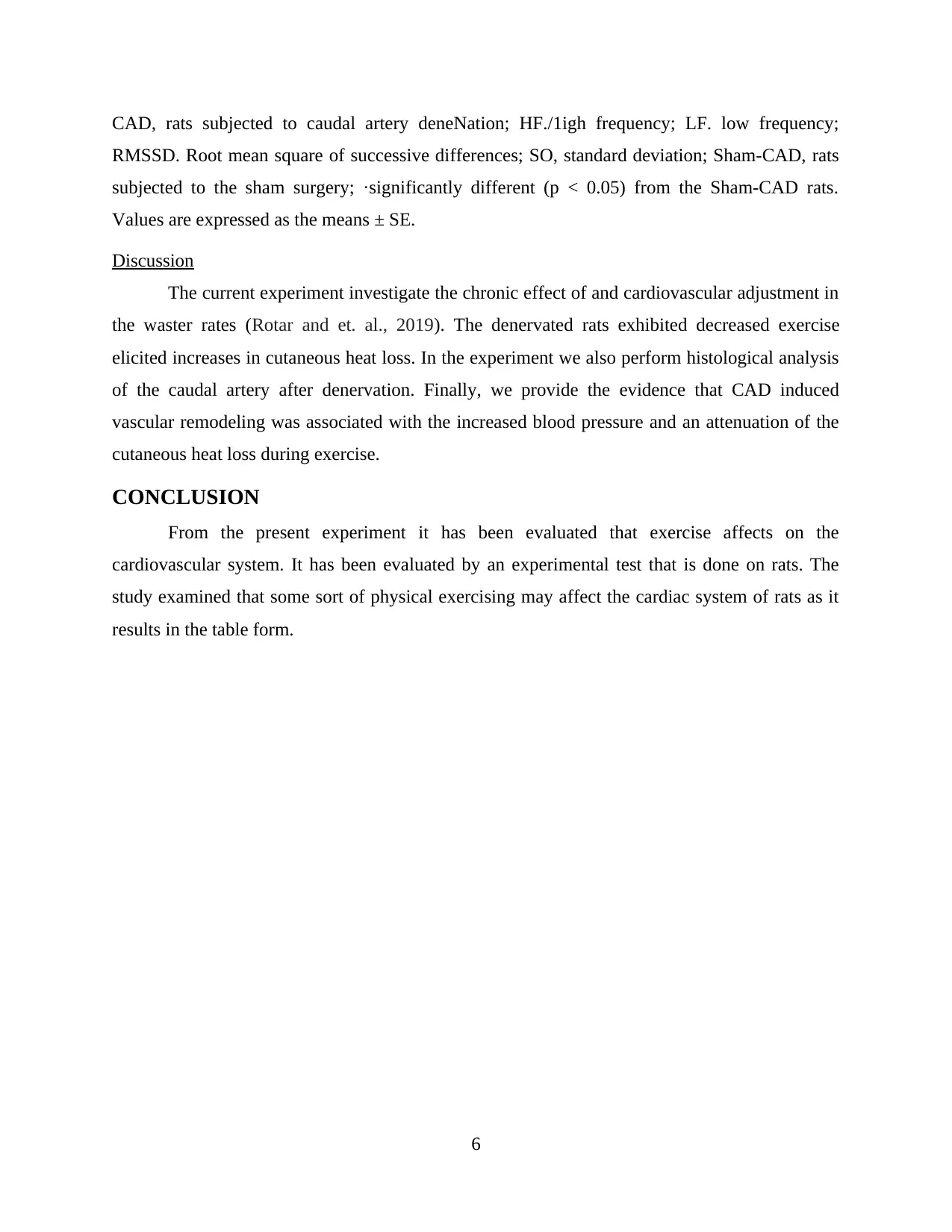
CAD, rats subjected to caudal artery deneNation; HF./1igh frequency; LF. low frequency;
RMSSD. Root mean square of successive differences; SO, standard deviation; Sham-CAD, rats
subjected to the sham surgery; ·significantly different (p < 0.05) from the Sham-CAD rats.
Values are expressed as the means ± SE.
Discussion
The current experiment investigate the chronic effect of and cardiovascular adjustment in
the waster rates (Rotar and et. al., 2019). The denervated rats exhibited decreased exercise
elicited increases in cutaneous heat loss. In the experiment we also perform histological analysis
of the caudal artery after denervation. Finally, we provide the evidence that CAD induced
vascular remodeling was associated with the increased blood pressure and an attenuation of the
cutaneous heat loss during exercise.
CONCLUSION
From the present experiment it has been evaluated that exercise affects on the
cardiovascular system. It has been evaluated by an experimental test that is done on rats. The
study examined that some sort of physical exercising may affect the cardiac system of rats as it
results in the table form.
6
RMSSD. Root mean square of successive differences; SO, standard deviation; Sham-CAD, rats
subjected to the sham surgery; ·significantly different (p < 0.05) from the Sham-CAD rats.
Values are expressed as the means ± SE.
Discussion
The current experiment investigate the chronic effect of and cardiovascular adjustment in
the waster rates (Rotar and et. al., 2019). The denervated rats exhibited decreased exercise
elicited increases in cutaneous heat loss. In the experiment we also perform histological analysis
of the caudal artery after denervation. Finally, we provide the evidence that CAD induced
vascular remodeling was associated with the increased blood pressure and an attenuation of the
cutaneous heat loss during exercise.
CONCLUSION
From the present experiment it has been evaluated that exercise affects on the
cardiovascular system. It has been evaluated by an experimental test that is done on rats. The
study examined that some sort of physical exercising may affect the cardiac system of rats as it
results in the table form.
6
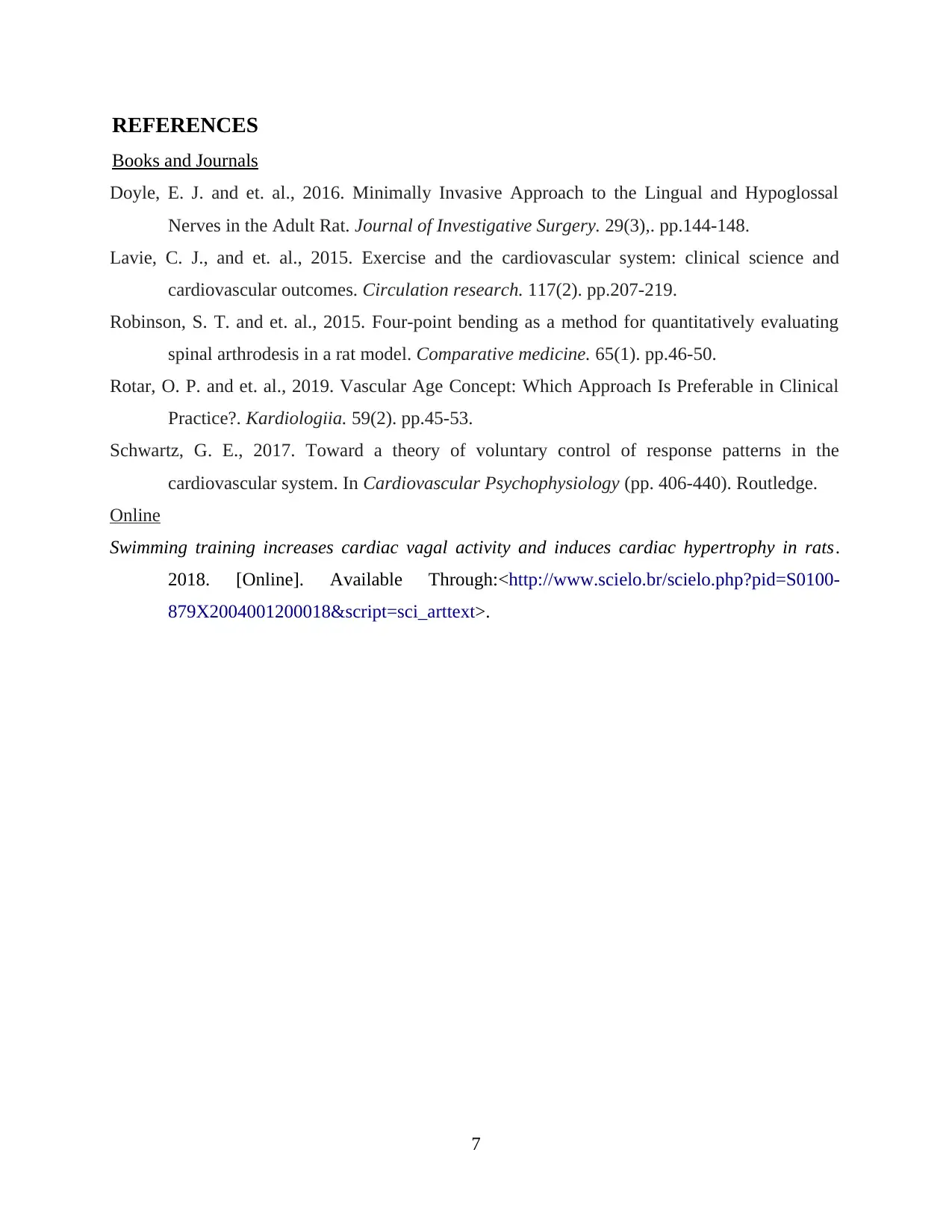
REFERENCES
Books and Journals
Doyle, E. J. and et. al., 2016. Minimally Invasive Approach to the Lingual and Hypoglossal
Nerves in the Adult Rat. Journal of Investigative Surgery. 29(3),. pp.144-148.
Lavie, C. J., and et. al., 2015. Exercise and the cardiovascular system: clinical science and
cardiovascular outcomes. Circulation research. 117(2). pp.207-219.
Robinson, S. T. and et. al., 2015. Four-point bending as a method for quantitatively evaluating
spinal arthrodesis in a rat model. Comparative medicine. 65(1). pp.46-50.
Rotar, O. P. and et. al., 2019. Vascular Age Concept: Which Approach Is Preferable in Clinical
Practice?. Kardiologiia. 59(2). pp.45-53.
Schwartz, G. E., 2017. Toward a theory of voluntary control of response patterns in the
cardiovascular system. In Cardiovascular Psychophysiology (pp. 406-440). Routledge.
Online
Swimming training increases cardiac vagal activity and induces cardiac hypertrophy in rats.
2018. [Online]. Available Through:<http://www.scielo.br/scielo.php?pid=S0100-
879X2004001200018&script=sci_arttext>.
7
Books and Journals
Doyle, E. J. and et. al., 2016. Minimally Invasive Approach to the Lingual and Hypoglossal
Nerves in the Adult Rat. Journal of Investigative Surgery. 29(3),. pp.144-148.
Lavie, C. J., and et. al., 2015. Exercise and the cardiovascular system: clinical science and
cardiovascular outcomes. Circulation research. 117(2). pp.207-219.
Robinson, S. T. and et. al., 2015. Four-point bending as a method for quantitatively evaluating
spinal arthrodesis in a rat model. Comparative medicine. 65(1). pp.46-50.
Rotar, O. P. and et. al., 2019. Vascular Age Concept: Which Approach Is Preferable in Clinical
Practice?. Kardiologiia. 59(2). pp.45-53.
Schwartz, G. E., 2017. Toward a theory of voluntary control of response patterns in the
cardiovascular system. In Cardiovascular Psychophysiology (pp. 406-440). Routledge.
Online
Swimming training increases cardiac vagal activity and induces cardiac hypertrophy in rats.
2018. [Online]. Available Through:<http://www.scielo.br/scielo.php?pid=S0100-
879X2004001200018&script=sci_arttext>.
7
⊘ This is a preview!⊘
Do you want full access?
Subscribe today to unlock all pages.

Trusted by 1+ million students worldwide

8
1 out of 10
Your All-in-One AI-Powered Toolkit for Academic Success.
+13062052269
info@desklib.com
Available 24*7 on WhatsApp / Email
![[object Object]](/_next/static/media/star-bottom.7253800d.svg)
Unlock your academic potential
© 2024 | Zucol Services PVT LTD | All rights reserved.

